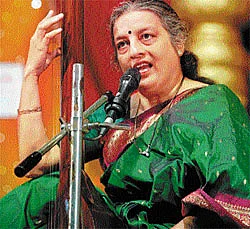
Today, Ashwini is a much-admired classical vocalist of the Jaipur-Atrauli Khayal-Gayaki gharana.
Her mellifluous voice which ranges over three octaves with ease, refined musical sensibilities and command over the aesthetics and techniques of classical music have earned her a place of respect among today’s Hindustani classical vocalists. She is also appreciated for her renditions in the semi-classical music genre, giving her music as much appeal to laypersons as connoisseurs and purists. Ashwini is also a composer with two books of lyrics to her credit — Ragarachananjali (Volumes One and Two). Ashwini has also recorded about 30 albums.
A long and rigorous period of training in music had preceded her career choice. Her initial lessons were under Pandit Narayanrao Datar. This was followed by advanced training from her mother Manik Bhide and Pandit Ratnakar Pai of the Jaipur-Atrauli Gharana.
Semi-classical music was imparted to her by her aunt Sarla Bhide, a disciple of Shobha Gurtu.
Recalling those days, she says, “From my teachers, I learnt more than music making. I was taught to believe that music was a divine art, and to approach it with devotion. Both my mother and Pandit Datar instilled great discipline in me. My whole perspective on life and music has been influenced by my mother.” She adds that Pandit Pai often told her not to count the hours of riyaaz as the quality of riyaaz counts over its quantity. “His simple and deep devotion to his own guru also inspired me.”
However, her decision was not impulsive. “I had to make a choice between classical music and academics. I decided to test the waters first. For a year I performed classical music to understand whether it could be sustained as a career. It turned out to be a rewarding experience. So I resolved that music would be my future.” However, Ashwini acknowledges there were benefits from her academic training too. “I am grateful to my biochemistry background which gave me a scientific approach and analytical mind — all greatly helpful in learning music, planning concerts, etc.”
Ashwini has arduously cultivated her own style of expression which is widely appreciated and has made her a sought-after performer. Whether with her richly emotive raga delineations and expositions of dhrupads and khayals with all their intricacies or her delightful semi-classical pieces, she ensures that her concerts have something for all kinds of music lovers. However, she has tended to be conservative, not attempting much fusion. Many Indian classical musicians of today are becoming part of fusion concerts.
What is her opinion about this recent phenomenon? She replies: “Actually, I do not believe that fusion is a recent trend in our country. Indian music is like an ever-flowing stream. We have been accepting and absorbing influences from all over the world, for centuries. Once upon a time, we had only temple music and dhrupad. When the Mughals came and brought their own style of singing, it influenced our music, leading to the birth of the khayal. So, fusion has been happening all the time and is probably unavoidable.'
In fact, Ashwini says the attitude of dismissing something new or foreign as not classical or ‘pure’ and believing that its intrusion or influence will detract from the pristine purity of our classical music does not make sense. “Fusion can be attempted if, in the process, you are ensuring that the sur and thaal of your music are kept intact and pure.”
However, a musician needs to exercise discrimination before attempting fusion with a foreign genre, she says. “If I were to be approached for a fusion concert, I would first consider whether the coming together of different streams will result in something meaningful and whether I will derive any pleasure from it. Will the concert generate something interesting and aesthetic? These would be my concerns in a fusion attempt.”
Many veterans and established musicians comment that today’s music students are a lucky lot. They have so many resources at their command — the internet, MP3, iPods, mobile phones. Any musician, raga or composition they want to listen to can be summoned to their presence, or listening ambit at least, at the touch of a button. What does Ashwini, who is also a respected teacher, say about this? “Yes, I agree this generation is indeed blessed — they have so many means to listen to the best of music and enrich themselves. However, not all of them make enough use of these things for musical betterment.”
To those who do, she says, there are great opportunities waiting. “However, music itself is a reward. To be able to sing or play great music or to appreciate and enjoy it as a music lover is in itself immensely satisfying, and a blessing.”
